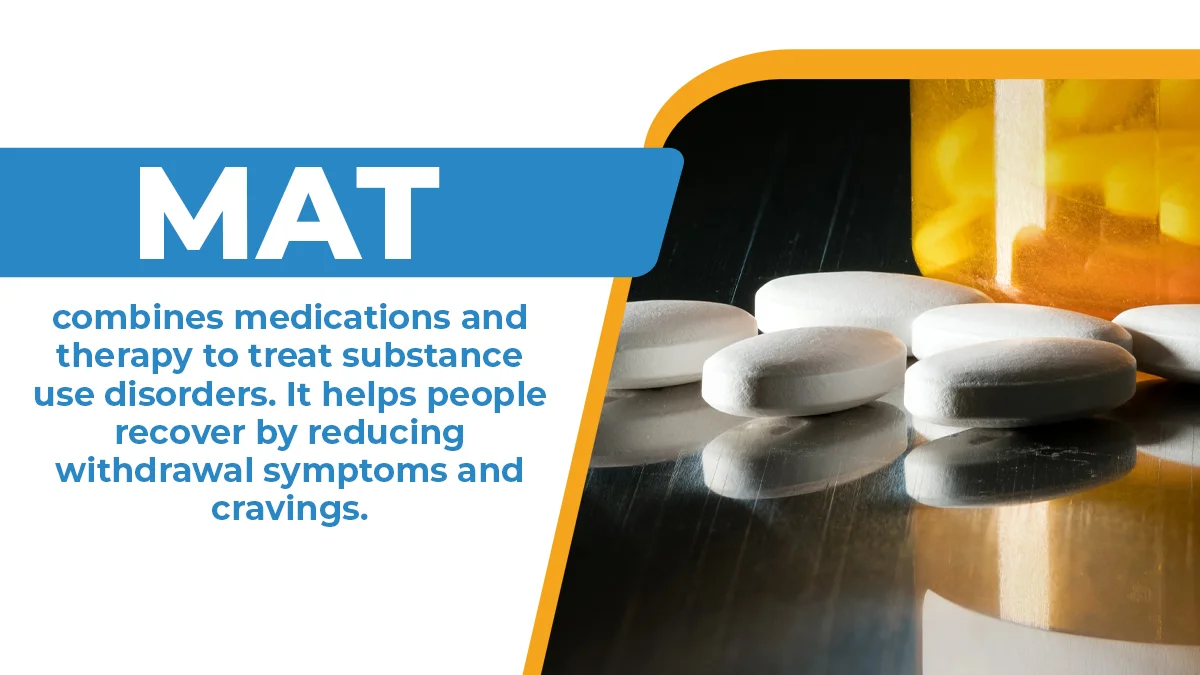
Effectiveness Of Medication-Assisted Treatment
Explore the effectiveness of medication-assisted treatment with The Recovery Team-Newton.

Medication-assisted treatment (MAT) for opioid dependence is an effective and comprehensive approach to overcoming addiction. Combining FDA-approved medications like methadone, buprenorphine, and naltrexone with counseling and behavioral therapies, MAT addresses both the physical and psychological aspects of addiction.
This evidence-based treatment reduces withdrawal symptoms and cravings, making it easier for individuals to focus on recovery. By integrating medication with support and therapy, MAT helps individuals regain control of their lives, lowers the risk of relapse, and improves overall health outcomes.
MAT medications block the effects of opioids, reduce cravings, and help normalize brain function without causing euphoria. Here’s what the article entails:
The Recovery Team-Newton offers reliable addiction recovery guidance to help you and your loved ones live healthier lives. Call us at (508) 978-2772 for more information.
Opioid dependence is a chronic condition where individuals rely on opioids, like prescription painkillers or heroin, to function. Over time, the body adapts to the drug, needing higher doses to attain the same effect.
This leads to physical and psychological dependency, making it hard to quit without experiencing withdrawal symptoms. Common signs include increased tolerance, cravings, and continued use despite negative consequences.
Medication-assisted treatment (MAT) is an inclusive method of treating opioid addiction that combines medications with counseling and behavioral therapies. Some of the primary medications used in MAT for opioid addiction include:
Methadone is a medication used to help people with opioid addiction. It works by changing how the brain and nervous system respond to pain. Methadone lessens withdrawal symptoms and cravings without causing the “high” associated with drug abuse.
Doctors prescribe methadone in a controlled setting, usually a clinic. Patients take methadone once a day, and it helps them focus on their recovery without the intense cravings.
Buprenorphine is another medication used in MAT. It binds to the same receptors in the mind as opioids but does not produce the same intense high. Buprenorphine reduces cravings and withdrawal symptoms.
It comes in various forms, such as tablets, films, or implants. Patients can take buprenorphine at home, making it more convenient than methadone. Buprenorphine helps people manage their addiction and lead normal lives.
Naltrexone is a medicine used to stop relapse in people who have stopped using opioids. It blocks the effects of opioids, making it impossible to get high. Naltrexone comes in pill form or as an injection. The injection, called Vivitrol, lasts for about a month.
Patients must be opioid-free for 7-10 days before starting naltrexone. This medication helps people stay in recovery by removing the desire to use opioids.
MAT combines medications and therapy to treat substance use disorders. It helps people recover by reducing withdrawal symptoms and cravings.
MAT saves lives by reducing the risk of overdose. Medications like methadone, buprenorphine, and naltrexone help stabilize brain chemistry. They prevent the euphoric effects of opioids, reducing the chance of misuse. By lowering cravings and withdrawal symptoms, MAT decreases the likelihood of relapse, which often leads to overdose. This approach has proven effective in cutting down on overdose deaths.
MAT improves the overall quality of life for individuals in recovery. With reduced cravings and withdrawal symptoms, people can focus on rebuilding their lives. They can maintain jobs, repair relationships, and engage in daily activities without the constant struggle of addiction.
MAT also helps manage co-occurring mental health disorders, contributing to better emotional stability. Combining medication and counseling supports long-term recovery, leading to healthier, more fulfilling lives.
MAT provides essential support for recovery from chronic diseases by combining medication with counseling and behavioral treatments. This holistic method addresses both the physical and psychological aspects of dependence. Counseling helps individuals develop coping strategies, build resilience, and address underlying issues.
The support from healthcare professionals and peer groups further strengthens the recovery process. By offering a comprehensive support system, MAT helps individuals stay committed to recovery and achieve lasting sobriety.
MAT, which combines medicines with counseling and behavioral interventions, addresses both the physical and psychological aspects of opioid use disorder.
Here are key components of integrating MAT with other forms of treatment:
Combining MAT with behavioral therapies is effective. MAT helps reduce cravings and withdrawal symptoms. Behavioral therapies, like Cognitive Behavioral Therapy (CBT), aid individuals in changing negative thoughts and behaviors. Together, they address both the physical and mental aspects of addiction. This combination improves the chances of long-term recovery. Therapies also teach coping skills to handle triggers and stress.
Counseling and support groups are crucial in MAT. Individual counseling provides a safe space to discuss personal challenges, helps identify and work through underlying issues, and offers peer support.
Sharing practices with others who comprehend can be very comforting. These groups create a sense of community and accountability. Both forms of counseling help individuals stay motivated and on track with their recovery goals.
Comprehensive care models integrate MAT with various treatments to provide holistic care. These models include medical, psychological, and social support. Patients receive tailored care plans tailored to their needs.
This approach often involves regular check-ups, therapy sessions, and support group meetings. Comprehensive care safeguards that all aspects of a person’s health are addressed. It provides continuous support, making managing recovery and preventing relapse easier. By addressing the whole person, not just the addiction, comprehensive care models promote overall well-being and lasting recovery.
Healthcare providers play a crucial role in MAT for opioid dependence. They assess patients, prescribe medications like methadone, buprenorphine, or naltrexone, and monitor progress. Providers also offer counseling and support to help patients manage cravings and avoid relapse. Their involvement is essential for creating personalized treatment plans that address both the physical and psychological aspects of dependence.
Training and education are important for healthcare providers involved in MAT. Providers must understand how different medications work and how to prescribe them safely. They need training on recognizing opioid use disorder and managing side effects.
Ongoing education ensures providers stay updated on new research and best practices, enabling them to deliver effective and compassionate care.
Implementing MAT requires following best practices to ensure success. Providers should create a welcoming environment where patients feel safe discussing their addiction. They must use evidence-based protocols for prescribing and monitoring medications.
Coordinating care with counselors and support groups helps address the full spectrum of patient needs. Regular follow-ups and adjusting treatment plans as needed are key to long-term recovery.
MAT is a key tool in fighting opioid dependence. The future holds exciting advancements in MAT, aiming to improve patient outcomes. Researchers are exploring new medications that offer better relief with fewer side effects. These innovations focus on personalized treatment plans tailored to individual needs, making recovery more effective.
Research and innovation are driving the future of MAT. Scientists are developing new drugs that target the brain’s addiction pathways more precisely. They are also working on long-acting formulations that reduce the need for frequent dosing, making it easier for people to stick to their treatment plans. Additionally, integrating MAT with other therapies like counseling and behavioral therapies is a major focus, ensuring a more holistic approach to recovery.
Policy changes and advocacy play a crucial role in the future of MAT. Advocates are pushing for laws that increase access to MAT and make it available to more needy people. Policies are being shaped to reduce the stigma around MAT, encouraging more individuals to seek help.
Efforts are also being made to ensure that insurance covers MAT, reducing the financial barriers to treatment. Together, these changes aim to create a supportive environment for those battling opioid dependence.
Medication-assisted treatment (MAT) for opioid use disorder (OUD) includes medications like methadone, buprenorphine, and naltrexone. Opioid Treatment Programs (OTPs) in the United States provide comprehensive services, including detoxification, psychosocial support, and treatment of opioid dependence. Clinical studies show MAT reduces opioid overdose and improves treatment outcomes.
MAT services address various medical conditions, combining medications with non-drug approaches to support recovery from opiates and substance abuse.
The most common form of medical treatment for opioid dependence is medication-assisted treatment (MAT). MAT combines FDA-approved medicines, such as methadone, buprenorphine, or naltrexone, with counseling and behavioral therapies to treat opioid use disorder.
Methadone and buprenorphine are often used to help decrease cravings and withdrawal symptoms, while naltrexone blocks the effects of opioids. MAT is effective in reducing opioid use, improving survival rates, and increasing retention in treatment programs.
MAT for opioid use disorder (OUD) combines FDA-approved medications like methadone, buprenorphine, or naltrexone with counseling and behavioral therapies. This comprehensive approach addresses both the physical and psychological aspects of addiction.
MAT reduces opioid cravings and withdrawal symptoms, helping individuals stabilize their lives and reduce the risk of overdose. It’s often provided in opioid treatment programs (OTPs) alongside psychosocial support and medical care.
Naloxone, a medication that can reverse opioid overdose, is also an important component of MAT. Clinical studies support the effectiveness of MAT in treating opioid dependence, offering hope for those struggling with OUD.
Defeat opioid dependence and step toward lasting recovery with The Recovery Team-Newton.
Our comprehensive day treatment program offers the support you need to reclaim control of your life. With medication-assisted treatment (MAT), we provide effective solutions to ease your journey toward recovery.
Furthermore, our experienced therapists offer evidence-based counseling and therapies tailored to build healthy coping mechanisms.
Don’t let opioid dependence hold you back any longer. Call us at (508) 978-2772 for further assistance.

Explore the effectiveness of medication-assisted treatment with The Recovery Team-Newton.

Explore the examples of dual diagnosis and its treatment plans for better outcomes with The Recovery Team-Newton.

Explore how long drug rehab programs are with the complete guide from The Recovery Team-Newton.